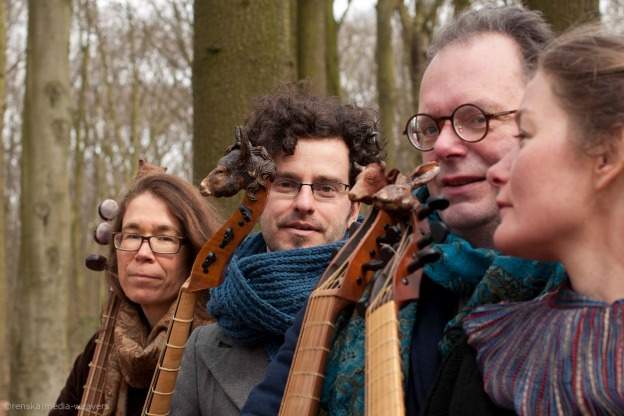
This week, we'll hear English consort music by John Jenkins and Christopher Tye in two recordings on the Musica Ficta label from the viol consort, The Spirit of Gambo: John Jenkins: Fantasias, Pavans & Airs in Four Parts and Christopher Tye: Consort Music-In Nomine.
Christopher Tye lived at the beginning of the 16th century. The exact date and place of Tye’s birth are unknown, but he was one of the first composers who wrote music for the viol consort.
For a while, viols had been playing contrapuntal vocal music reworked for instruments, with viols replacing voices. But soon after, the viol consort came into its own. Vocal masses were often composed around a cantus firmus melody, and consort music often followed suit, taking an underlying melody as the basis around which other contrapuntal parts were freely composed.
A very famous example of this cantus firmus type of consort piece was the In Nomine, which was part of a plainchant melody from the “in nomine Domine” section of the Benedictus of a mass composed by one of Tye’s contemporaries, John Taverner. (And by the way, if you’re curious to know more about the origins of In nomine, here's a link to a “catchy tunes” segment on our website.)
Virtually every significant English composer of consort music until Henry Purcell wrote in nomines. But out of all them Christopher Tye was one of the first to jump on the "in nomine" bandwagon. Twenty-one of Tye’s 30 or so extant consort works are, in fact, In nomines.
It might seem a tall order to compose so many pieces around the same tune, yet Tye manages to give each of his a special character, supplemented even with curious and sometimes witty titles like “Follow me,” “Blamles,” or “Free from All.”
Most of Tye’s in nomines are in five parts and in duple meter, like one titled “Crye.” But Tye composed at least one In nomine for six parts. Perhaps giving a nod to the viol consorts vocal origins, The Spirit of Gambo adds soprano Claron McFadden to the ensemble of five viols to fill that sixth and additional part. And while most of Tye’s in nomines are in duple meter, the composer had a little fun with a couple settings. One, titled “Trust,” is in the very precarious meter of 5/4, while in another called “Howld fast,” Tye writes the cantus firmus in a completely different meter than that of the other parts. Here’s some of "Howld fast."
Tye died sometime before 1573, but he was memorialized long after his death in a 17th-century play by Samuel Rowley, which includes the text:
England one God, one truth, one Doctor hath
For Musicks Art, and that is Doctor Tye.
Following in the footsteps of "Doctor Tye," John Jenkins, in the 17th century, greatly expanded the viol consort in terms of both repertory and sophistication.
Jenkins lived a long life and thus saw a lot of changes in musical styles. Following in the footsteps of Byrd and Gibbons, Jenkins died just as Purcell was making a splash onto the musical scene. In contrast to Tye, we have an abundance of music left to us by John Jenkins: over 800 of his instrumental works survive, a few of which may be heard on The Spirit of Gambo’s CD of John Jenkins' Fantasias, Pavans and Airs in Four Parts.
Jenkins' fantasias generally begin with a fugal or imitative section, as in his Fantasia XV in C for two trebles, two basses and organ. Besides the fantasias on this recording, there are several airs, pavans, and a galliard that are by comparison significantly less contrapuntal than the fantasias. The pavan was a fixture of the viol consort repertoire, characterized usually by its slow tempo and stately mood, in contrast to the quick and more lively galliard.
A word about the instruments used by The Spirit of Gambo ensemble: they are built by one of the founding members of the group, Gesina Liedmeier. Here's a link to a video in which you’ll be able to see pictures of these beautifully crafted instruments.
The Spirit of Gambo has been around since the mid 1980s, and over the years, they’ve amassed many recordings. The two consort recordings we’ve been hearing on the podcast today were released in 2013 and 2014. In between, the group also put out a recording of Orlando Gibbons’ madrigals and motets.
Thanks for listening!









